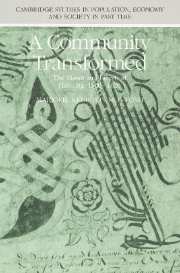Book contents
- Frontmatter
- Contents
- List of figures
- List of tables
- Acknowledgements
- Abbreviations
- Introduction
- 1 Life and death
- 2 Changing economic patterns
- 3 Religion
- 4 Facets of a society in transition
- 5 Havering's declining independence
- 6 Overt conflict, 1607–19
- Conclusion
- Appendices
- Bibliography
- Index
- Cambridge Studies in Population, Economy and Society in Past Time
4 - Facets of a society in transition
Published online by Cambridge University Press: 11 October 2009
- Frontmatter
- Contents
- List of figures
- List of tables
- Acknowledgements
- Abbreviations
- Introduction
- 1 Life and death
- 2 Changing economic patterns
- 3 Religion
- 4 Facets of a society in transition
- 5 Havering's declining independence
- 6 Overt conflict, 1607–19
- Conclusion
- Appendices
- Bibliography
- Index
- Cambridge Studies in Population, Economy and Society in Past Time
Summary
Several social and cultural developments had a significant impact upon Havering's history between 1500 and 1620. Education and use of art forms separated the various strata within the community while also helping the wealthiest families to become members of a wider culture at a regional or national level. Philanthropic responses too differed between occupational groups. Throughout the sixteenth and early seventeenth centuries, assistance to the poor was given selectively, but the middling families who had traditionally administered charity were displaced after 1600 by the very wealthiest houses. The changing roles of women increased the differences between their lives and men's at the same time as they gained new functions within the household. Although the three topics to be considered in this chapter are only indirectly related to each other, each is intimately connected with the central themes of our analysis.
Education, literacy, and the arts
In Havering, education and culture were viewed in pragmatic terms–valued if they helped a person or family to gain a better living, hold office, or display status. The levels of schooling and literacy were surprisingly low after the 1550s, although there were marked contrasts between the gentry, the middling families, and the poor. Training in the law was seen as a route upward by a handful of ambitious urban yeomen or families with an existing legal connexion. By around 1600 the sons of the wealthiest families were attending a university and generally one of the Inns of Court, thereby becoming part of a broader social and political culture involving young men from throughout England.
- Type
- Chapter
- Information
- A Community TransformedThe Manor and Liberty of Havering-atte-Bower 1500–1620, pp. 259 - 296Publisher: Cambridge University PressPrint publication year: 1991

